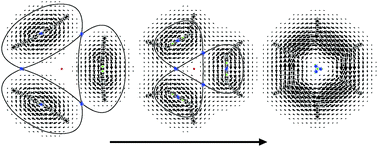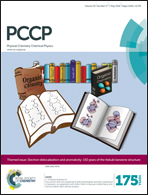The making of ring currents†
Abstract
Benzene, planar cyclooctatetraene, and borazine have been taken into account as archetypal aromatic, anti-aromatic, and non-aromatic systems. Then, the making of the π-electron diatropic ring current of benzene, huge paratropic ring current of planar cyclooctatetraene, and weak diatropic ring current of borazine, has been monitored by means of DFT calculations of current density maps and bond current strengths along a concerted, highly symmetric reaction pathway for the trimerization and tetramerization of acetylene to benzene and planar cyclooctatetraene and the trimerization of the simplest iminoborane (BH2N) to borazine. Besides, a simple model is presented that permits to infer the presence of a ring current only on account of the sum of homotropic local vortices. The model works satisfactorily for borazine and surely as well for benzene with a substantial difference. On the one hand, for borazine, the evolution of the current density along the formation reaction can be recast summing three virtually unchanged diatropic current loops with respect to parent iminoborane molecules. On the other hand, the benzene ring current is an emerging property that can be re-elaborated as the sum of three diatropic current loops of increased diatropicity with respect to parent acetylene molecules, i.e., the radius of the maximum current increases form 0.76 to 0.97 Å and the current strength increases from 3.6 to 6.7 nA T−1. In these terms, the difference between the aromatic benzene and non-aromatic borazine can be understood as the attitude of the acetylene molecules to form always wider and stronger current loops as they get closer, a behavior not shared by the iminoborane molecules. For planar cyclooctatetraene, the paratropic circulation arising from the HOMO–LUMO transition makes the model inapplicable, since the initial hypothesis of homotropic circulations over the reaction coordinate is violated. In a sense, the fact that the model works only for a bit of the planar cyclooctatetraene formation reaction is itself distinctive of the anti-aromatic magnetic response.

- This article is part of the themed collection: Electron delocalization and aromaticity: 150 years of the Kekulé benzene structure

 Please wait while we load your content...
Please wait while we load your content...